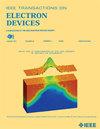High-Performance LLSAW Devices on X-Cut LiNbO₃ Thin Film With Bragg Reflector for n78 Band Applications
IF 2.9
2区 工程技术
Q2 ENGINEERING, ELECTRICAL & ELECTRONIC
引用次数: 0
Abstract
In this work, a range of high-performance longitudinal leaky surface acoustic wave (LLSAW) devices based on a composite substrate structure are designed and fabricated, specifically aimed at the 5G new radio (NR) n78 band. The substrate comprises an X-cut lithium niobate (LN) thin film and a Bragg reflector composed of alternating layers of SiO2 and Ta2O5. The fabricated LLSAW resonators exhibit exceptional performance with high admittance ratio (AR) and large electromechanical coupling coefficient (用于n78波段应用的带Bragg反射器的X-Cut LiNbO 3薄膜上的高性能LLSAW器件
在这项工作中,设计和制造了一系列基于复合衬底结构的高性能纵向泄漏表面声波(LLSAW)器件,专门针对5G新无线电(NR) n78频段。衬底包括x切割的铌酸锂(LN)薄膜和由SiO2和Ta2O5交替层组成的Bragg反射器。所制备的LLSAW谐振器在3.2-3.7 GHz频率范围内表现出高导纳比(AR)和大机电耦合系数($\text {k}_{\text {t}}^{{2}}$)的优异性能。具体来说,以3.317 GHz为中心的谐振器实现了67 dB的AR, $\text {k}_{\text {t}}^{{2}}$为20.4%,Bode-Qmax为1219。此外,该中心频率为3.4 GHz的滤波器的最小插入损耗(IL)为1.35 dB, 3-dB带宽为433 MHz, n41频段的衰减为43 dB。该滤波器还具有- 35.6/ - 40.2 ppm/°C的低温频率系数(TCF)。该滤波器的1 db压缩点(P1dB)为15.2 dBm,输入三阶截距点(IIP3)为52.3 dBm,适用于高线性、中等功率的射频应用。这些结果证明了基于x切割LN薄膜和SiO2/Ta2O5反射器的LLSAW技术在先进的5G通信应用中的潜力。
本文章由计算机程序翻译,如有差异,请以英文原文为准。
求助全文
约1分钟内获得全文
求助全文
来源期刊

IEEE Transactions on Electron Devices
工程技术-工程:电子与电气
CiteScore
5.80
自引率
16.10%
发文量
937
审稿时长
3.8 months
期刊介绍:
IEEE Transactions on Electron Devices publishes original and significant contributions relating to the theory, modeling, design, performance and reliability of electron and ion integrated circuit devices and interconnects, involving insulators, metals, organic materials, micro-plasmas, semiconductors, quantum-effect structures, vacuum devices, and emerging materials with applications in bioelectronics, biomedical electronics, computation, communications, displays, microelectromechanics, imaging, micro-actuators, nanoelectronics, optoelectronics, photovoltaics, power ICs and micro-sensors. Tutorial and review papers on these subjects are also published and occasional special issues appear to present a collection of papers which treat particular areas in more depth and breadth.
 求助内容:
求助内容: 应助结果提醒方式:
应助结果提醒方式:


